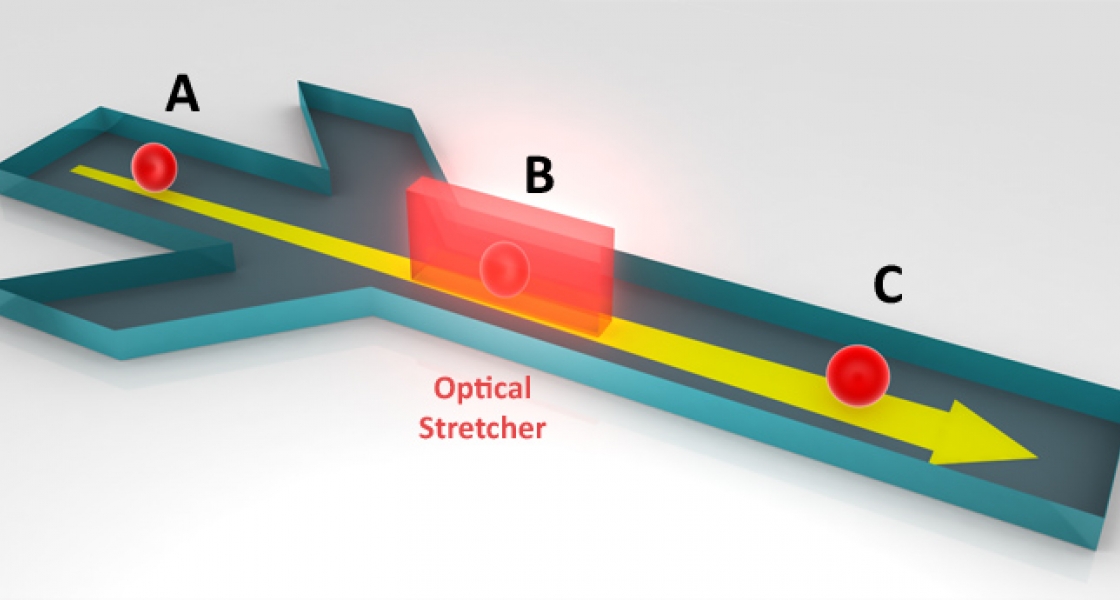Fellow Ralph Jimenez is applying his knowledge of lasers, microscopy, and the precise control of tiny amounts of fluids to the development of a battery-powered blood analyzer for use "off-grid" in Third World countries. He is collaborating with Jeff Squier, David Marr, and their students from the Colorado School of Mines and Charles Eggleton and his student from the University of Maryland, Baltimore County, to see if they can come up with a fast and accurate way to measure the elasticity, or stiffness, of individual red blood cells as they flow through an "optical lab on a chip."
One trick to developing a useful medical device is finding a way to rapidly and accurately measure each cell’s ability to stretch and relax (i.e., the "spring constant") for thousands of individual blood cells. Such measurements allow researchers to identify the cells and look for evidence of aging, cancer, or diseases such as malaria. They would enormously simplify the way blood analysis is done in the hematology analyzer instruments currently used in clinical laboratories.
As a first step in developing a blood analyzer, Jimenez and his colleagues have come up with a single-laser technique that can rapidly stretch and relax individual red blood cells as they flow through a tiny microfluidics chamber. For example, the red blood cell shown in the figure is (A) relaxed as it enters the microfluidics chamber, (B) stretched by the light from a diode laser, and (C) relaxed when the laser is turned off. The researchers are able to measure the deformation of this and other cells with respect to the angle of the laser beam and do the measurements hundreds of times faster than with techniques developed by others.
Jimenez and his colleagues have also created numerical simulations of this experiment to model the elastic response of red blood cells to optical forces. The simulations verified not only that a single laser beam can induce cell stretching, but also that precise measurements of this deformation allow for the determination of the spring constant of individual cells. Taken together, the results of the simulations and the experiment suggest that the new laser-based screening method could become the foundation for the development of a new mechanical property-based cytometry (the counting and identification of cells with a specialized device). - Julie Phillips



 The Physics Frontiers Centers (PFC) program supports university-based centers and institutes where the collective efforts of a larger group of individuals can enable transformational advances in the most promising research areas. The program is designed to foster major breakthroughs at the intellectual frontiers of physics by providing needed resources such as combinations of talents, skills, disciplines, and/or specialized infrastructure, not usually available to individual investigators or small groups, in an environment in which the collective efforts of the larger group can be shown to be seminal to promoting significant progress in the science and the education of students. PFCs also include creative, substantive activities aimed at enhancing education, broadening participation of traditionally underrepresented groups, and outreach to the scientific community and general public.
The Physics Frontiers Centers (PFC) program supports university-based centers and institutes where the collective efforts of a larger group of individuals can enable transformational advances in the most promising research areas. The program is designed to foster major breakthroughs at the intellectual frontiers of physics by providing needed resources such as combinations of talents, skills, disciplines, and/or specialized infrastructure, not usually available to individual investigators or small groups, in an environment in which the collective efforts of the larger group can be shown to be seminal to promoting significant progress in the science and the education of students. PFCs also include creative, substantive activities aimed at enhancing education, broadening participation of traditionally underrepresented groups, and outreach to the scientific community and general public.